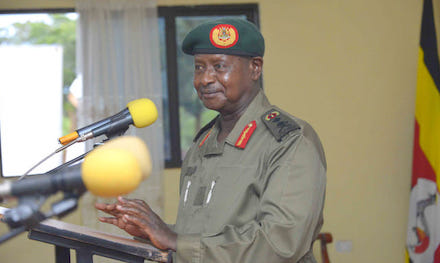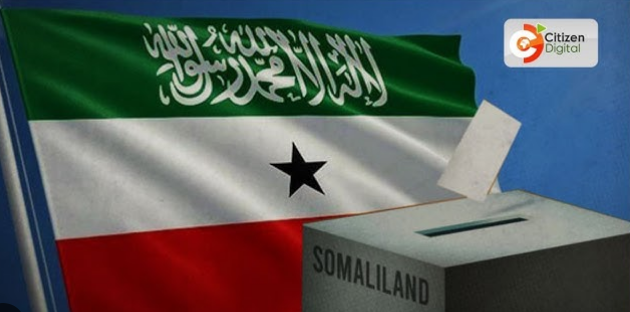Gen. Museveni–Uganda’s most sectarian ruler since independen in 1962.
Historians and experts on predicting the future of States, particularly the rise and fall of great powers, would readily admit that they did not see the fall of the Union of Soviet Socialist Republics (USSR) coming. The Berlin Wall came down in 1989. Within two years, in December of 1991, the mighty Soviet Union disintegrated and collapsed without a single shot being fired in anger. Two other important states soon fell apart. First was the Socialist Federal Republic of Yugoslavia (SFRY), resulting in a bitter armed conflict. Second was Czechoslovakia. She was dissolved without having gone through armed conflicts.
Will the current Uganda, an authoritarian State eventually collapse considering the mess and insecurity dictator Yoweri Museveni Tibuhaburwa, has imposed for 40 years now? He launched a bloody insurrection on February 6, 1981 and ultimately seized power in 1986. As Ugandans, we need to look at historical conditions that led to the collapse of the three states I’ve mentioned and draw our own conclusions. I have intentionally left out the situations of Ethiopia and Eritrea, Sudan and South Sudan, and the attempted secession of Biafra from Nigeria, because Uganda’s possible collapse does not necessarily require wars to trigger it.
Vladimir Lenin was the leader of the October Revolution and the first leader and founder of the USSR. Founded in 1917, the USSR was led by Lenin until his death in 1924 after a series of strokes. The USSR collapsed under the leadership of Mikhail Gorbachev, the eighth and last leader of the Soviet Union as General Secretary of the Communist Party from 1985-1991. Historians advance many reasons for the fall of the USSR, including the invasion of Afghanistan and its heavy toll, and the high level of military spending—diverting away from social programs—during the arms race with the United States. What most scholars agree on is the fact that poor leadership and economic stagnation contributed to the Soviet Union’s collapse. Uganda under Museveni faces a similar crisis. As a State, the USSR—even with its large economic base and its level of industrialization—was no longer able to satisfactorily take care of its population by providing social services, medical care and education. The Soviets had lost their sense of invincibility, pride and dignity. Gorbachev gave up pretending that the USSR was a great power and dropped the ball. A near alcoholic opportunist, Boris Yeltsin, took over the rump Russian Federation as President and ran the country to the ground. Vladimir Putin is now busy trying to recover past glory.
The situations in the former Yugoslavia and Czechoslovakia are dissimilar from the USSR. Yugoslavia came into existence after the First World War in 1918 under the name of the kingdom of Serbs, Croats and Slovenes, formed from the former Austro-Hungarian Empire. The monarchy was abolished in November 1945, and Yugoslavia was re-named the Federal Republic of Yugoslavia in 1946 when the Communist Party was established. In 1963, the country was re-named again, as the Socialist Federal Republic of Yugoslavia (SFRY). Its founding leader, Josip Broz Tito, ruled the country until his death in 1980 when the country began to unravel.
After Tito’s death, the six constituent republics that made up the SFRY—Bosnia and Herzegovina, Croatia, Macedonia, Montenegro, Serbia and Slovenia Serbia, which contained autonomous Provinces of Vojvodina and Kosovo—broke up along its republics borders, leading to the Yugoslav wars. From 1993 to 2017, the International Criminal Tribunal for the former Yugoslavia (ICTY) prosecuted political and military leaders from the former Yugoslavia for war crimes, genocide and crimes against humanity committed during the wars.
With respect to Czechoslovakia, the country existed from 1918 when it declared independence from Austria-Hungry. Czechoslovakia consistently struggled to maintain independence and assert her sovereignty from major powers but eventually disintegrated in January 1993 when it split into two sovereign states: the Czech Republic and Slovakia. The great experiment had failed.
Uganda’s history, though dissimilar with the USSR and the eastern European states referred to above, can be understood by studying Ramkrishna Mukherjee’s aptly titled seminal book, “Uganda: An Historical Accident, Class, Nation, State Formation” (1985). Can this “accidental state” survive the mess, the mass corruption, torture, state murders, and destruction of Gen. Museveni Tibuhaburwa and his goons?
The signs that Uganda is heading for disintegration are out there for all to see. In 1894, the territory that became Uganda, under British colonizers, was declared a British protectorate. The Kingdom of Buganda became the staging post for British imperialism. The 1900 Buganda Agreement granted to the kingdom of Buganda a special status which she enjoyed until 1962. Even then, the 1962 independence Constitution preserved the special status of Buganda, effectively granting it the status of a state-within-a-state. Since then, Buganda has been, and shall continue to be, Uganda’s Achilles heels, its soft underbelly until its relationship with the rest of the country is re-negotiated and resolved.
The late prime minister—later president—Milton Obote, tried and failed to appease Buganda. In 1963, Obote persuaded his party, the Uganda Peoples Congress (UPC) to vote for Sir Edward Mutesa, the Kabaka—king—of Buganda, as president of Uganda against William W.W Nadiope, Kabazinga of Busoga, and the preferred UPC candidate. Kabaka Mutesa became president of Uganda with Obote as executive prime minister. Obote was head of the central government; his relationship with Buganda was rocky and did not improve. The arrangement failed. Eventually, in 1966, Obote drove Mutesa out of the country when the constitutional crisis came to a boil and in 1967 he abolished all kingdoms in Uganda. Buganda never forgave Obote for his actions. Obote and the UPC lost Buganda for ever.
Next, enters Gen. Idi Amin and his antics. In 1971, after he seized power, Gen. Amin began to court Buganda in order to build a political base for his military junta. He brought back to Uganda the remains of Sir Edward Mutesa and offered a State funeral. Gen Amin appointed scores of Baganda in his cabinet. But soon, Amin fell out with Buganda and began murdering members of the Buganda community alongside other ethnic groups, particularly Acholi and Lango. By the time Amin was removed in 1979 by the Tanzania People’s Defense Force (TPDF)—after he had invaded and occupied parts of Tanzania—the Kingdom of Buganda, and most Ugandans, had rejected the dictator. However, most Ugandans still believed in the State called Uganda. The experiment of building Uganda, though complicated, was still a work in progress.
While Obote and Amin “used” Buganda to provide political and economic support, Gen. Museveni used the people of Buganda to fight his wars of insurgency and to die for him. When Museveni launched his war in February 1981, it was in Buganda’s Luwero region, and it was the Baganda men and women who constituted the majority of his fighters. The Baganda provided him with shelter, food and intelligence. Museveni created insecurity and blamed it on Obote and the UPC. Even though Obote’s army committed atrocities in fighting the rebels, it’s now known that many of the crimes against civilians were carried out by Museveni’s fighters who then blamed them on Obote’s soldiers. This falsehood-strategy became the policy of Museveni’s National Resistance Army (NRA).
During the war years of 1981 to 1986, Gen. Museveni relied on Buganda for his survival. When he desperately needed to prove to Buganda that he loved them, Gen. Museveni invited the late Sir Edward’s son, Ronald Mutebi–now Kabaka–to Masaka to address the Baganda and asked the local community to support him and the NRA. All these actions were nothing but perfidy. However, the Baganda fighters joined Museveni in their thousands. One of the top Buganda leaders in the so-called “Bush War” was Andrew Lutakoome Kayiira. His military faction, the Uganda Freedom Movement (UFM), captured Kampala on January 25, 1986, and handed it over to Museveni’s NRA. It did not take long before Museveni ordered the murder of Kayiira.
After the just concluded January 14, 2021 presidential and parliamentary elections, the Baganda, by more than 90%, rejected Gen. Museveni and his party, the NRM. Besides Buganda, there is a resurgent Bunyoro; with her recently acquired oil wealth, this region is no longer willing or ready to play second fiddle. Bunyoro now demands her equitable dues. The northern part of the country, long brutalized and neglected by Gen. Museveni and the NRA, currently conducts more business in South Sudan and eastern Democratic Republic of the Congo (DRC) than with Kampala, the Ugandan capital. The eastern border nations of Jophadola, Bugisu, Samia and Sebei, look to Kenya for business, education and medical services than to Kampala.
For Museveni to allege that those who voted for candidate Robert Kyagulanyi, a.k.a, Bobi Wine are “sectarian” is not only grossly disingenuous, but plain stupidity. Gen. Museveni should look in the mirror and examine members of his cabinet, starting with his wife—perhaps the most unqualified minister of education anywhere —to find out the definition of sectarianism. The most sectarian institutions in Uganda under Gen. Museveni include the security organs, civil service, cabinet, and the judiciary. These sectarian acts have nothing to do with Buganda or Kyagulanyi. Gen. Museveni is the master of ethnic-apartheid.
Kyagulanyi is the first Ugandan leader, of Ganda origin, since 1962, to enjoy widespread support in most parts of Uganda. Indeed, Kyagulanyi is more popular than Gen. Museveni, whose own people in his Western region did not vote for him in 1980 when he lost his parliamentary seat to Sam Kutesa, the current foreign minister. Since he started organizing his elections in 1996, Museveni has rigged every vote. He needs to stop peddling lies about “Buganda sectarianism” and address the real problems that he created in Uganda, commencing with insecurity that he initiated in February 1981 and is still continuing.
As Gen. Museveni Tibuhaburwa continues to destroy Uganda, the country is steadily disintegrating while many politicians are not paying attention. When the NRM members of Parliament are busy looting the country, they may sooner rather than later discover that the constituencies they claim to represent no longer exist. The ethnic-bigot Museveni once referred to people from the northern part of Uganda as “swine” and “cockroaches”—now he has co-opted some such as Jacob Olanya, Hilary Onek, Oryem Okello, Taban Amin, and Betty Amongi Akena, and other riff-raff in his cabinet and security agencies, to cover up his sectarianism. Of course, he makes sure they wield no power or influence.
Finally, Gen. Museveni after 35 years of totalitarian rule and ethno-bigotry, has created conditions conducive for Buganda to opt out of Uganda. When eventually Buganda leaves the Uganda experiment, other nationalities shall follow and there shall be no more Uganda for Museveni to destroy. All people of good will who want to preserve the Ugandan state must come together to resist Museveni’s totalitarian madness and remove him.
Dr. Obote Odora is a Consultant






